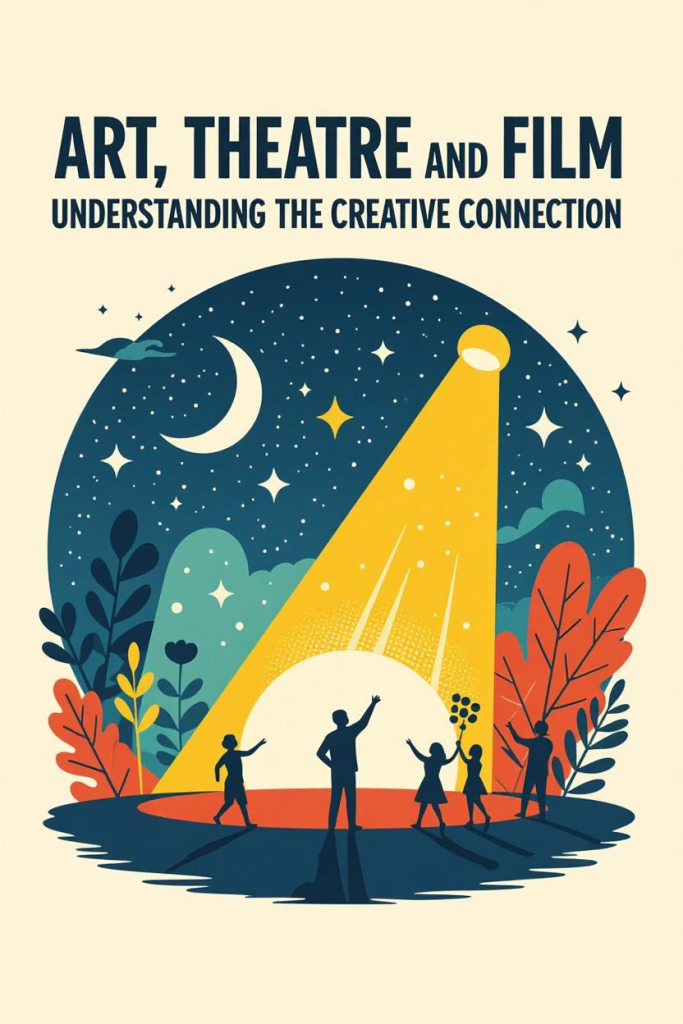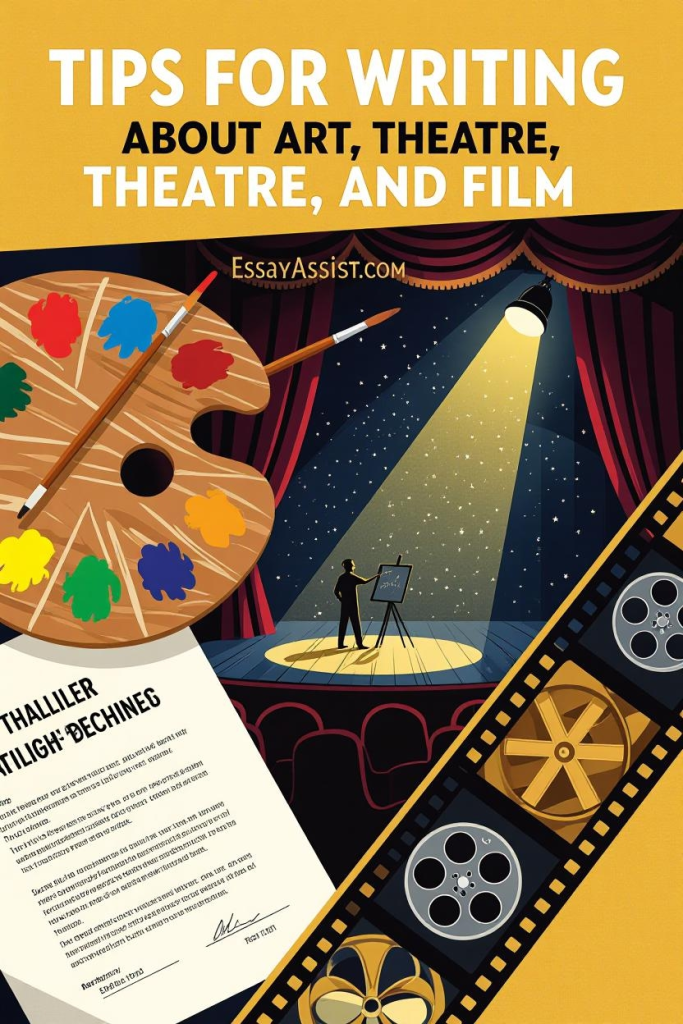
Updated: 26 October 2025
Written by: Kennedy Muthee
Introduction
Art, theatre, and film are three of the most powerful forms of creative expression. They not only entertain but also reflect the depth of human emotion, thought, and experience. Each medium tells a story — through colors, movements, or camera angles — inviting audiences to see the world through new perspectives.
At Essayassists, we believe understanding these creative fields allows students to develop critical thinking, emotional intelligence, and cultural awareness — skills essential in today’s interconnected world.
The Essence of Art: Visual Language of Emotion
Art is the purest form of human expression. It captures emotion in ways that words cannot. Through painting, sculpture, photography, or digital design, artists reveal the unseen — feelings, beliefs, and perspectives that shape society.
Art communicates through color, form, and symbolism. It challenges assumptions and encourages reflection. Whether displayed in a gallery or shared online, every piece invites a dialogue between creator and viewer, making it a timeless element of human culture.
Theatre: The Living Stage of Human Experience
Theatre transforms stories into shared experiences. It merges dialogue, emotion, and performance to explore the human condition in real time. From ancient Greek tragedies to contemporary plays, theatre brings communities together and inspires empathy.
On stage, actors become storytellers of truth — revealing joy, pain, and transformation. This immediacy makes theatre one of the most engaging and educational forms of art. It not only entertains but also provokes thought, helping audiences see themselves reflected in each performance.
Film: The Modern Fusion of Art and Performance
Film combines visual art, literature, and performance into one powerful storytelling medium. Directors and cinematographers use light, motion, and sound to evoke emotions and convey meaning.
Modern cinema builds upon both artistic composition and theatrical performance. From set design inspired by fine art to acting techniques borrowed from the stage, film merges creativity with technology to create experiences that transcend time and language.
In today’s digital era, film also serves as a tool for education, activism, and cultural preservation — proving its significance beyond entertainment.
The Connection Between Art, Theatre, and Film
Though each discipline stands on its own, they share the same creative heartbeat — expression.
- Art provides the foundation for design, color, and mood.
- Theatre contributes storytelling, dialogue, and live emotion.
- Film brings both together, capturing the depth of human experience through motion and sound.
This interconnection allows artists to inspire one another. A painting can influence a film’s cinematography, while a play can shape cinematic storytelling. Together, they form a continuous dialogue between imagination and reality.
The Role of Creative Arts in Education and Society
The creative arts are vital to both personal and societal development. In education, they enhance problem-solving, communication, and empathy. Through studying art, theatre, and film, students learn to interpret ideas critically and express them creatively.
In society, the arts encourage unity and cultural understanding. They document history, challenge injustice, and inspire progress. Supporting the creative industries is not just about preserving tradition — it’s about nurturing innovation and human connection.
How Essayassists Helps Art Students Succeed

Art students often face a unique set of challenges. Whether it’s writing analytical essays about artworks, preparing research papers on theatre history, or crafting reviews of modern films, the creative field demands both imagination and academic precision. That’s where Essayassists steps in — offering professional academic support tailored to the needs of art and design learners.
1. Expert Guidance on Art, Theatre, and Film Essays
Essayassists connects students with subject-specific experts who understand both theory and creativity. Writers help students analyze visual elements, interpret symbolism, and apply critical frameworks like formalism, semiotics, or postmodernism. This ensures that every paper goes beyond description — it becomes an insightful academic analysis.
2. Assistance with Research and Citations
Art students often struggle to find credible sources or correctly cite visual materials. Essayassists provides structured research support, helping students use academic databases, reference exhibition catalogs, and apply citation styles such as MLA, APA, or Chicago with precision.
3. Editing and Proofreading for Clarity and Flow
Strong artistic ideas can lose impact when presented with unclear writing. Essayassists editors refine tone, structure, and grammar while preserving each student’s creative voice. The goal is simple: make academic writing as compelling and expressive as the art it discusses.
4. Visual and Performance Analysis Support
For those studying theatre and film, Essayassists offers guidance on scene analysis, stage direction interpretation, and film critique techniques. Writers help students break down cinematography, set design, lighting, and performance — turning subjective reactions into structured academic discussion.
5. Personalized Project Help
From museum reflection papers to creative portfolios, Essayassists provides customized support to fit every assignment type. Whether students are preparing an artist statement or writing a comparative essay on two plays, they receive guidance that blends creativity with scholarly standards.
6. Developing Academic Confidence
Beyond completing assignments, Essayassists focuses on long-term growth. By learning how to structure arguments, interpret visual culture, and apply critical theories, art students become more confident and independent writers — skills that carry over into their professional artistic careers.
Final Thoughts
Essayassists empowers art students to express creativity with academic rigor. By combining artistic understanding with expert writing support, it helps learners produce essays, analyses, and critiques that meet university standards while celebrating individuality.
Whether you’re exploring the symbolism of Renaissance art, analyzing a Broadway play, or dissecting a film’s visual language, Essayassists ensures your ideas are presented clearly, creatively, and professionally.
Tips for Writing About Art, Theatre, and Film

Writing about art, theatre, and film requires a balance between creativity and analysis. It’s not just about describing what you see — it’s about interpreting, evaluating, and connecting ideas in a clear, academic way. Whether you’re reviewing a painting, analyzing a play, or critiquing a film, your writing should reflect both insight and emotion.
At Essayassists, we guide students to approach creative writing with structure, clarity, and depth. Here are expert-backed tips to help you write effectively about these artistic disciplines.
1. Understand the Context
Before analyzing any artwork, play, or film, take time to understand its background. Learn about the artist, the time period, and the cultural influences that shaped the piece.
Context gives meaning — it helps you interpret creative choices and understand their relevance to history and society.
2. Go Beyond Description
Avoid simply describing what you see or watch. Instead, focus on why the artist, playwright, or director made certain choices. Discuss how lighting, composition, dialogue, or sound contribute to the overall message.
Strong analysis explains significance, not just surface details.
3. Use Sensory and Descriptive Language
Artistic writing thrives on vivid imagery. Use sensory words to help readers visualize what you are discussing.
Example: Instead of saying “The scene was emotional,” say “The dim lighting and trembling voice of the actor conveyed a quiet despair that filled the room.”
4. Apply Critical Theories and Frameworks
Support your interpretation with academic approaches — such as formalism, realism, symbolism, or postmodern theory. In film or theatre, you might also reference cinematic techniques, stage direction, or performance analysis.
This adds intellectual weight to your essay and shows mastery of the discipline.
5. Reference Real Examples
Use examples from famous or relevant works to illustrate your points. Compare the techniques of artists like Van Gogh and Picasso, or contrast a Shakespearean play with a modern adaptation.
Examples make your arguments concrete and relatable.
6. Balance Emotion with Objectivity
It’s natural to have a personal reaction to creative works, but combine your emotional response with critical evaluation. Express what you felt and explain why you felt it.
This dual approach creates a more thoughtful, persuasive analysis.
7. Structure Your Essay Clearly
Follow a logical academic structure:
- Introduction: Present the topic and thesis.
- Body Paragraphs: Analyze key elements or scenes.
- Conclusion: Summarize insights and emphasize the work’s impact.
A clear structure ensures your ideas flow smoothly and maintain reader engagement.
8. Cite Your Sources Properly
When referencing artworks, plays, or films, always credit creators and critics. Use the citation style required by your institution (MLA, APA, or Chicago). Proper citation strengthens your credibility and academic integrity.
9. Edit for Tone and Clarity
Great writing is also great editing. Review your essay for clarity, grammar, and consistency in tone. Make sure transitions are smooth and your arguments connect naturally.
Essayassists editors always recommend reading your work aloud — it helps catch awkward phrasing or unclear logic.
10. Keep Your Voice Authentic
Even in academic writing, your unique voice matters. Don’t be afraid to express personal insight or creative thought — just support it with research and reason. Your analysis should reflect both your understanding and your perspective.
FAQs on Art, Theatre, and Film

1. Why are art, theatre, and film often studied together?
Art, theatre, and film are deeply connected because they all express human experience through creativity. While art focuses on visual composition, theatre brings stories to life through performance, and film combines both with motion and sound. Studying them together helps students understand how different artistic disciplines influence one another.
2. What skills do students develop when studying the arts?
Students develop creativity, critical thinking, cultural awareness, and communication skills. The study of arts also enhances emotional intelligence and helps learners interpret social issues from multiple perspectives.
3. How has theatre influenced modern film?
Film evolved directly from theatre. Early cinema borrowed stage techniques such as dialogue-driven scripts, dramatic lighting, and character development. Even today, many film directors and actors rely on theatrical principles to create authentic, powerful performances.
4. Why is art important in education?
Art education encourages self-expression, innovation, and visual literacy. It helps students think critically, solve problems creatively, and appreciate diverse cultures. By engaging with art, learners gain skills that are valuable in both academic and professional settings.
5. What is the difference between visual art, theatre, and film?
- Visual art involves still images like paintings, drawings, and sculptures.
- Theatre uses live performance to tell stories on stage.
- Film captures and edits moving images to convey ideas through cinematography and sound.
Though distinct, all three rely on creativity, emotion, and storytelling.
6. How can students write strong essays about art, theatre, and film?
Start by researching background information, analyzing artistic elements, and interpreting meaning. Use descriptive language, cite sources correctly, and maintain a clear essay structure. Combining observation with critical analysis will make your writing both academic and engaging.
7. How does Essayassists support art students?
Essayassists helps students craft well-structured essays, critiques, and research papers on art, theatre, and film. Its academic experts guide learners in analysis, writing, and citation, ensuring their creative ideas meet professional academic standards.
8. What career paths can come from studying art, theatre, and film?
Graduates can pursue careers in education, production, design, directing, museum curation, media analysis, or creative writing. The arts also strengthen transferable skills such as communication, leadership, and critical reasoning — valuable in many industries.
9. How do the arts impact society today?
Art, theatre, and film reflect social issues, inspire empathy, and promote cultural dialogue. They challenge norms, celebrate diversity, and encourage audiences to think critically about the world. In short, they shape how society expresses and understands itself.
10. Can creativity and academic writing coexist?
Absolutely. Academic writing in the arts thrives when creativity is guided by structure. Essayassists encourages students to express originality while maintaining scholarly rigor — ensuring that creativity and professionalism work hand in hand.
Conclusion
Art, theatre, and film are timeless reflections of who we are as humans. Each discipline teaches us to see the world differently — to question, feel, and imagine. Together, they form the foundation of creativity, connecting generations through expression and storytelling. Writing about art, theatre, and film allows students to combine critical thinking with creativity. It’s a journey through emotion, technique, and culture — one that challenges you to see beyond the surface.
At Essayassists, we help students master this craft by teaching them how to observe, analyze, and express with clarity and confidence. With the right structure and mindset, your words can become as powerful as the art you write about. At Essayassists, we continue to support students and writers in exploring these art forms with insight and confidence. Whether you’re analyzing a painting, reviewing a play, or studying film, remember — every piece of art is a conversation waiting to be understood.
